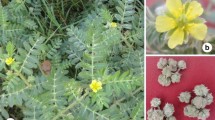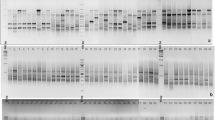Abstract
Curcuma longa L., commonly known as turmeric, is one of the economically and medicinally important plant species. It is predominantly cultivated in the tropical and sub tropical countries. India is the largest producer, and exporter of turmeric in the world, followed by China, Indonesia, Bangladesh and Thailand. In the present study, Directed Amplification of Minisatellite DNA (DAMD) and Inter Simple Sequence Repeats (ISSR), methods were used to estimate the genetic variability in indigenous turmeric germplasm. Cumulative data analysis for DAMD (15) and ISSR (13) markers resulted into 478 fragments, out of which 392 fragments were polymorphic, revealing 82 % polymorphism across the turmeric genotypes. Wide range of pairwise genetic distances (0.03–0.59) across the genotypes revealed that these genotypes are genetically quite diverse. The UPGMA dendrogram generated using cumulative data showed significant relationships amongst the genotypes. All 29 genotypes studied grouped into two clusters irrespective of their geographical affiliations with 100 % bootstrap value except few genotypes, suggesting considerable diversity amongst the genotypes. These results suggested that the current collection of turmeric genotypes preserve the vast majority of natural variations. The results further demonstrate the efficiency and reliability of DAMD and ISSR markers in determining the genetic diversity and relationships among the indigenous turmeric germplasm. DAMD and ISSR profiling have identified diverse turmeric genotypes, which could be further utilized in various genetic improvement programmes including conventional as well as marker assisted breeding towards development of new and desirable turmeric genotypes.


Similar content being viewed by others
References
Angle GR, Makeshkumar T, Mohan C, Vimala B, Nambisan B (2008) RAPD genetic diversity analysis of starchy Curcuma species using markers. Plant Biochem Biotechnol 17:0971–781
Araujo CAC, Leon LL (2001) Biological activities of Curcuma longa L. Mem. Inst. Mem Inst Oswaldo Cruz 96:723–728
Botstein D, White RL, Skolnick M, Davis RW (1980) Construction of a genetic linkage map in man using restriction fragment length polymorphism. Am J Hum Genet 32:314–331
Chandra R, Desai AR, Govind S, Gupta PN (1997) Metroglyph analysis in turmeric (Curcuma longa L.) germplasm in India. Sci Hortic 70:211–222
Chandra R, Govind S, Desai AR (1999) Growth, yield and quality performance of turmeric (Curcuma longa L.) genotypes in mid-altitudes of Meghalaya. J Appl Hortic (Lucknow) 1:142–144
Das A, Kesari V, Satyanarayana VM, Parida A, Rangan L (2011) Genetic relationship of Curcuma species from Northeast India using PCR-based markers. Mol Biotechnol 49(1):65–76
Doyle JJ, Doyle JL (1990) Isolation of plant DNA from fresh tissue. Focus 12:13–15
Duke JA (2003) CRC handbook of medicinal spices. CRC Press, Boca Raton
Hayakawa HYM, Ito K, Yamamoto Y, Fukuda T (2011a) Difference of curcumin content in Curcuma longa L (Zingiberaceae) caused by Hybridization with other Curcuma species. Am J Plant Sci 2(2):111–119
Hayakawa TK, Minamiya Y, Ito K, Miyazaki A, Fukuda T, Yamamoto Y (2011b) Development of a molecular marker to identify a candidate line of turmeric (Curcuma longa L.) with a high curcumin content. Am J Plant Sci 2(1):15–26
Heath DD, Iwana GK, Delvin RH (1993) PCR primed with VNTR core sequences yield species specific patterns and hypervariable probes. Nucleic Acids Res 21:5782–5785
Hodgkin T, Roviglioni R, de Vicente MC, Dudnik N (2001) Molecular methods in the conservation and use of plant genetic resources. Acta Hortic 546:107–118
Huey B, Hall J (1989) Hypervariable DNA fingerprinting in Escherichia coli: minisatellite probe from bacteriophage M13. J Bacteriol 171:2528–2532
Hussain Z, Tyagi RK, Sharma RA, Agarwal A (2008) Genetic diversity in in vitro conserved germplasm of Curcuma longa as revealed by RAPD markers. Biol Plant 52:627–633
Jan UH, Rabbani MA, Shinwari ZK (2011) Assessment of genetic diversity of indigenous turmeric (Curcuma longa L.) germplasm from Pakistan using RAPD markers. Med Plant Res 5(5):823–830
Jeffereys AJ, Wilson V, Thein SL (1985) Hypervariable ‘minisatellite’ regions in human DNA. Nature 314:67–73
Joshi RK, Kuanar A, Mohanty S, Subudhi E, Nayak S (2010) Mining and characterization of EST derived microsatellites in Curcuma longa L. Bioinformatics 5(3):128–132
Kang HW, Park DS, Go SJ, Eun MY (2002) Fingerprinting of diverse genomes using PCR with universal rice primers generated from repetitive sequences of Korean weedy rice. Mol Cells 13:281–287
Keeratinijakal V, Kladmook M, Laosatit K (2010) Identification and characterization of Curcuma comosa Roxb, phytoestrogens-producing plant, using AFLP markers and morphological characteristics. J Med Plant Res 4(24):2651–2657
Mantel N (1967) The detection of disease clustering and a generalized regression approach. Cancer Res 27:209–220
May A, Cecilio FAB, Cavarianni RL, Barbosa JC (2005) Turmeric (Curcuma longa L.) development and productivity in function at nitrogen and potassium doses Rev. Bras. Planta Med 7:73–78
Meenakshi N, Sulikeri GS (2003) Effect of different planting materials on growth, yield and productivity of turmeric (Curcuma longa L.). Int J Trop Agric 21:37–44
Milbourne D, Meyer RC, Bradshaw JE, Baird E, Bonar N, Provan J, Powell W, Waugh R (1997) Comparison of PCR-based marker systems for the analysis of genetic relationships in cultivated potato. Mol Breed 3:127–136
Murray MJ, Haldeman BA, Grant FJ, O’Hara PJ (1988) Probing the human genome with minisatellite-like sequences from the human coagulation factor VII gene. Nucleic Acids Res 16:4166
Nakamura Y, Carlson M, Krapcho K, Kanamori M, White R (1988) New approach for the isolation of VNTR markers. Am J Hum Genet 43:854–859
Nayak S, Naik P, Acharya L, Pattnaik A (2006) Detection and evaluation of genetic variation in 17 promising cultivars of turmeric (Curcuma longa L.) using 4C nuclear DNA content and RAPD markers. Cytologia 71:49–55
Nesbitt KA, Potts BM, Vaillancourt RE, West AK, Reid JB (1995) Partitioning and distribution of RAPD variation in a forest tree species, Eucalyptus globulus (Myrtaceae). Heredity 74:628–637
Page RDM, TreeView (Win32), ver. 165, 2001; http://taxonomy.zoology.gla.ac.uk/rod/treeview.html
Panda MK, Mohanty S, Subudhi E, Acharya L, Nayak S (2007) Assessment of genetic stability of micropropagated plants of Curcuma longa L. by cytophotometry and RAPD analysis. Int J Integr Biol 1:189–195
Pavlicek A, Hrda S, Flegr J (1999) FreeTree – freeware program for construction of phylogenetic trees on the basis of distance data and bootstrapping/jackknife analysis of the tree robustness application in the RAPD analysis of the genus Frenkelia. Folia Biol (Praha) 45:97–99
Powell W, Morgante M, Andre C, Hanafey M, Vogel J, Tingey S, Rafalski A (1996) The comparison of RFLP, RAPD, AFLP and SSR (microsatellite) markers for germplasm analysis. Mol Breed 2:225–238
Prevost A, Wilkinson MJ (1999) A new system comparing PCR primers applied to ISSR fingerprinting of potato cultivars. Theor Appl Genet 98:107–12
Ravindran PN, Babu KN, Sivaranan K (2007) Turmeric: the genus Curcuma. Medicinal and aromatic plants - industrial profiles. CRC Press, Boca Raton
Rohlf FJ (1998) NTSYS-pc: numerical taxonomy and multivariate analysis system, version 202e Applied Biostatistics Inc. Exeter Software, Setauket
Salvi ND, George L, Eapen S (2001) Plant regeneration from leaf base callus of turmeric and random amplified polymorphic DNA analysis of regenerated plants. Plant Cell Tissue Organ Cult 6:113–119
Sasikumar B (2005) Genetic resources of Curcuma: diversity, characterization and utilization. Plant Genet Res 3:230–251
Selvan TM, Thomas KG (2002) Turmeric In: Singh HP, Sivaraman KT, Selvan M, (Eds) Indian spices - production and utilization proceedings, national consultative meeting for accelerated production and export of spices 97-109 coconut development board, Cochin
Shamina A, Zachariah TJ, Sasikumar B, Johnson KG (1998) Biochemical variation in turmeric (C. longa) accessions based on isozyme polymorphism. J Hortic Sci Biotechnol 73:479–483
Sigrist MS, Pinheiro JB, Azevedo-Filho JA (2010) Development and characterization of microsatellite markers for turmeric (Curcuma longa). Plant Breed 129(5):570–573
Siju S, Dhanya K, Syamkumar S, Sheeja TE, Sasikumar B, Bhat AI, Parthasarathy VA (2010) Development, characterization and utilization of genomic microsatellite markers in turmeric (Curcuma longa L). Biochem Syst Ecol 38:641–646
Singh S, Niranjan A, Sharma SK, Tewari SK (2011) Curcuminoids, phenolic contents and yield investigations of Curcuma longa L. accessions, grown on partially reclaimed sodic soil. Med Plants Int J PhytomedicineRelat Ind 3(3):203–207
Syamkumar S (2008) Molecular biochemical and morphological characterization of selected Curcuma accessions. Ph D Thesis Calicut University, Calicut, India
Thaikert R, Paisooksantivatana Y (2009) Variation of total curcuminoids content, antioxidant activity and genetic diversity in turmeric (Curcuma longa L.) collections. Kasetsart J (Nat Sci) 43:507–518
Tingey SV, Tufo JP (1993) Genetic analysis with random amplified polymorphic DNA markers. Plant Physio 101:349–352
Tyagi RK, Agarwal A, Mahalakshmi C, Hussain Z, Tyagi H (2007) Low cost media for in vitro conservation of turmeric (Curcuma longa L.) and genetic stability assessment using RAPD markers. In Vitro Cell Dev Biol Plant 43:51–58
Velayudhan KC, Muralidharan VK, Amalraj VA, Gautam PL, Mandal S, Kumar D (1999) Curcuma genetic resources scientific monograph No 4 (1-5). National Bureau of Plant Genetic Resources, New Delhi
Vergnaud G (1989) Polymers of random short oligonucleotides detect polymorphic loci in the human genome. Nucleic Acids Res 17:7623–7630
Verma S, Rana TS, Ranade SA (2009) Genetic variations and clustering in Murraya paniculata complex, revealed by single primer amplification reaction (SPAR) methods. Curr Sci 96(9):1210–1216
Vijayalatha KR, Chezhiyan N (2008) Multivariate based marker analysis in turmeric (Curcuma longa L.). J Hortic Sci 3(2):107–111
Winberg BC, Zhou Z, Dallas JF, McIntyre CL, Gustafson JP (1993) Characterization of minisatellite sequences from Oryza sativa. Genome 36:978–983
Zhou Z, Bebeli PJ, Somers DJ, Gustafson JP (1997) Direct amplification of minisatellite-region DNA with VNTR core sequences in the genus Oryza. Theor Appl Genet 95:42–949
Acknowledgments
This work was financially supported by the Council of Scientific and Industrial Research (CSIR), New Delhi under the grant BSC0110 (AGTEC). The authors would like to thank Director, CSIR-National Botanical Research Institute, Lucknow (India) for facilities and encouragements.
Author information
Authors and Affiliations
Corresponding author
Rights and permissions
About this article
Cite this article
Verma, S., Singh, S., Sharma, S. et al. Assessment of genetic diversity in indigenous turmeric (Curcuma longa) germplasm from India using molecular markers. Physiol Mol Biol Plants 21, 233–242 (2015). https://doi.org/10.1007/s12298-015-0286-2
Received:
Revised:
Accepted:
Published:
Issue Date:
DOI: https://doi.org/10.1007/s12298-015-0286-2




